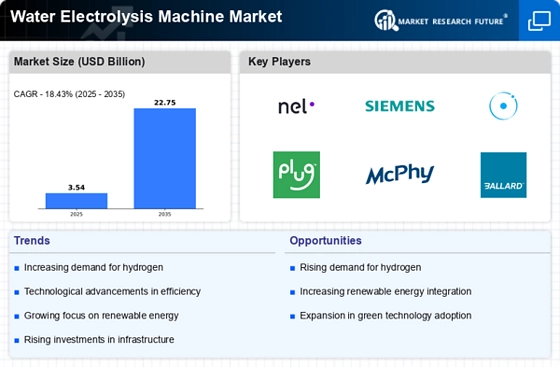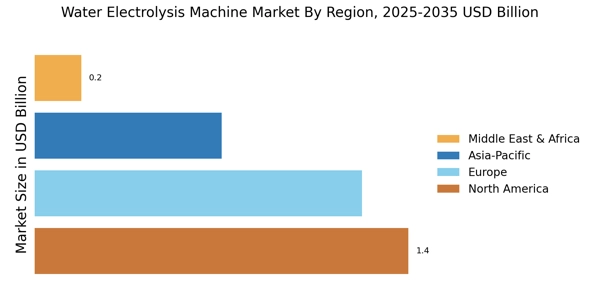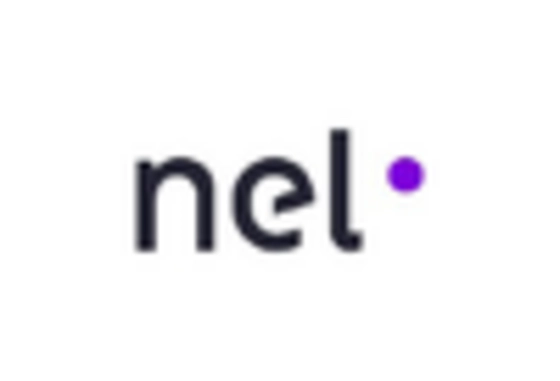Technological Innovations
Technological advancements play a pivotal role in shaping the Water Electrolysis Machine Market. Innovations in electrolysis technology, such as the development of more efficient catalysts and membrane materials, are enhancing the performance and reducing the operational costs of water electrolysis systems. For instance, advancements in proton exchange membrane (PEM) electrolysis are enabling higher efficiency rates, which could potentially lower the cost of hydrogen production. The market is witnessing a surge in investments aimed at improving the scalability and reliability of these machines. As a result, the Water Electrolysis Machine Market is expected to expand significantly, with projections indicating a market size reaching several billion dollars by 2030. This trend suggests that ongoing research and development will continue to drive the market forward.
Rising Environmental Concerns
The increasing awareness regarding environmental degradation and climate change is propelling the Water Electrolysis Machine Market. As nations strive to reduce carbon emissions, the demand for clean hydrogen production through electrolysis is gaining traction. This method is seen as a sustainable alternative to fossil fuels, aligning with global efforts to transition towards greener energy sources. The market is projected to witness a compound annual growth rate (CAGR) of approximately 8% over the next five years, driven by the need for eco-friendly solutions. Furthermore, industries are increasingly adopting hydrogen as a clean fuel, which is likely to further stimulate the Water Electrolysis Machine Market. Companies are investing in research and development to enhance the efficiency of electrolysis technologies, indicating a robust future for this sector.
Industrial Applications and Demand
The diverse applications of hydrogen produced through water electrolysis are significantly influencing the Water Electrolysis Machine Market. Industries such as transportation, chemicals, and power generation are increasingly recognizing the potential of hydrogen as a clean energy carrier. The transportation sector, in particular, is exploring hydrogen fuel cells as a viable alternative to conventional fuels, which is likely to drive demand for water electrolysis machines. Additionally, the chemical industry is utilizing hydrogen for various processes, further expanding the market's reach. As industries seek to decarbonize their operations, the Water Electrolysis Machine Market is poised for growth, with estimates suggesting a market expansion that could exceed USD 10 billion by 2030. This trend underscores the importance of hydrogen in achieving sustainability goals.
Government Initiatives and Incentives
Government policies and incentives are crucial drivers of the Water Electrolysis Machine Market. Many governments are implementing supportive frameworks to promote the adoption of hydrogen technologies as part of their energy transition strategies. Initiatives such as subsidies, tax incentives, and funding for research projects are encouraging investments in water electrolysis systems. For example, several countries have set ambitious hydrogen production targets, which are likely to create a favorable environment for the Water Electrolysis Machine Market. The European Union's Green Deal and various national hydrogen strategies are indicative of this trend. As these policies gain traction, the market is expected to experience accelerated growth, with an increasing number of projects aimed at integrating hydrogen into energy systems.
Growing Investment in Renewable Energy
The escalating investment in renewable energy sources is a significant driver of the Water Electrolysis Machine Market. As the world shifts towards sustainable energy solutions, the integration of water electrolysis with renewable energy sources, such as solar and wind, is becoming increasingly prevalent. This synergy allows for the production of green hydrogen, which is essential for decarbonizing various sectors. The market is witnessing a surge in projects aimed at coupling electrolysis systems with renewable energy plants, which is likely to enhance the viability of hydrogen as a clean energy source. Reports indicate that investments in renewable energy are expected to reach trillions of dollars in the coming years, thereby providing a robust foundation for the Water Electrolysis Machine Market. This trend suggests a promising outlook for the sector as it aligns with global energy transition goals.


















Leave a Comment